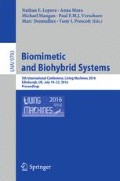Abstract
The Hybrid Neuroprosthesis (HNP) is a hydraulically actuated exoskeleton and implanted Functional Electrical Stimulation (FES) system that has been designed and fabricated to restore gait to people with spinal cord injuries. The exoskeleton itself does not supply any active power, instead relying on an implanted FES system for all active motor torques. The exoskeleton instead provides support during quiet standing and stance phases of gait as well as sensory feedback to the stimulation system. Three individuals with implanted functional electrical stimulation systems have used the system to successfully walk short distances, but were limited in the flexion torques the stimulation system could provide.
Access this chapter
Tax calculation will be finalised at checkout
Purchases are for personal use only
References
To, C.S., Kobetic, R., Schnellenberger, J.R., Audu, M.L., Triolo, R.J.: Design of a variable constraint hip mechanism for a hybrid neuroprosthesis to restore gait after spinal cord injury. IEEE/ASME Trans. Mechatron. 13(2), 197–205 (2008)
Hirokawa, S., Grimm, M., Le, T., Solomonow, M., Baratta, R.V., Shoji, H., D’Ambrosia, R.D.: Energy consumption in paraplegic ambulation using the reciprocating gait orthosis and electrical stimulation of the thigh muscles. Arch. Phys. Med. Rehabil. 71, 687–694 (1990)
Solomonow, M., Baratta, R., Hirokawa, S., Rightor, N., Walker, W., Beaudette, P., Shoji, H., D’Ambrosia, R.: The RGO generation II: muscle stimulation powered orthosis as a practical walking system for thoracic paraplegics. Orthopedics 12, 1309–1315 (1989)
Isakov, E., Douglas, R., Berns, P.: Ambulation using the reciprocating gait orthosis and functional electrical stimulation. Paraplegia 30, 239–245 (1992)
Goldfarb, M., Durfee, W.: Design of a controlled-brake orthosis for FES-added gait. IEEE Trans. Rehabil. Eng. 4(1), 13–24 (1996)
Goldfarb, M., Korkowski, K., Harrold, B., Durfee, W.: Preliminary evaluation of a controlled-brake orthosis for FES-aided gait. IEEE Trans. Neur. Syst. Rehabil. Eng. 11(3), 241–248 (2003)
Ha, K.H., Murray, S.A., Goldfarb, M.: An approach for the cooperative control of FES with a powered exoskeleton during level walking for persons with paraplegia. IEEE Trans. Neur. Syst. Rehabil. Eng. (99), 1
del-Ama, A., Gil-Agudo, Á., Pons, J., Moreno, J.: Hybrid FES-robot cooperative control of ambulatory gait rehabilitation exoskeleton. J. NeuroEng. Rehabil. 11(1), 27 (2014)
Kobetic, R., Marsolais, E.B.: Synthesis of paraplegic gait with multichannel functional neuromuscular stimulation. IEEE Trans. Rehabil. Eng. 2(2), 66–79 (1994)
Marsolais, E.B., Kobetic, R.: Development of a practical electrical stimulation system for restoring gait in the paralyzed patient. Clin. Orthop. (233), 64–74 (1988)
Alojz, K., et al.: Gait restoration in paraplegic patients: a feasibility demonstration using multichannel surface electrode FES. J. Rehabil. R&D/Veterans Adm. Dept. Med. Surg. Rehabil. R&D Serv. 20(1), 3–20 (1983)
Kobetic, R., Triolo, R.J., Marsolais, E.B.: Muscle selection and walking performance of multichannel FES systems for ambulation in paraplegia. IEEE Trans. Rehabil. Eng. 5(1), 23–29 (1997)
Acknowledgements
The author would like to thank all APT Center and FES Center investigators and engineers that contributed to this work, including Dr. Musa Audu, Kevin Foglyano, and John Schnellenberger. This work was supported by grants from the Department of Defense (W81XWH-13-1-0099), and the Rehabilitation Research and Development Service of Veteran Affairs (B0608-R).
Author information
Authors and Affiliations
Corresponding author
Editor information
Editors and Affiliations
Rights and permissions
Copyright information
© 2016 Springer International Publishing Switzerland
About this paper
Cite this paper
Nandor, M.J., Chang, S.R., Kobetic, R., Triolo, R.J., Quinn, R. (2016). A Hydraulic Hybrid Neuroprosthesis for Gait Restoration in People with Spinal Cord Injuries. In: Lepora, N., Mura, A., Mangan, M., Verschure, P., Desmulliez, M., Prescott, T. (eds) Biomimetic and Biohybrid Systems. Living Machines 2016. Lecture Notes in Computer Science(), vol 9793. Springer, Cham. https://doi.org/10.1007/978-3-319-42417-0_18
Download citation
DOI: https://doi.org/10.1007/978-3-319-42417-0_18
Published:
Publisher Name: Springer, Cham
Print ISBN: 978-3-319-42416-3
Online ISBN: 978-3-319-42417-0
eBook Packages: Computer ScienceComputer Science (R0)

